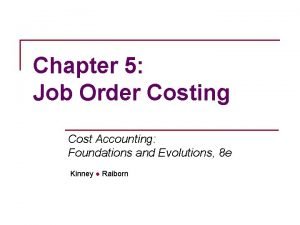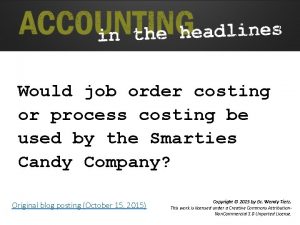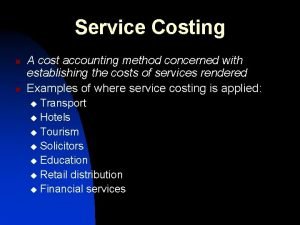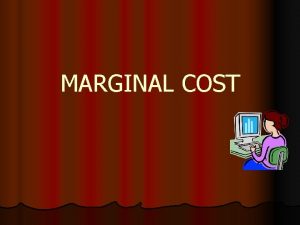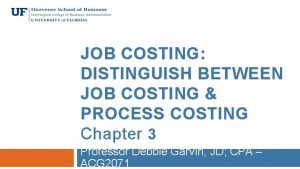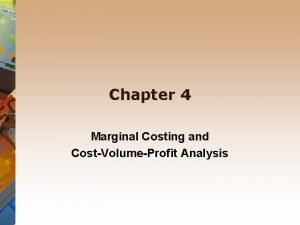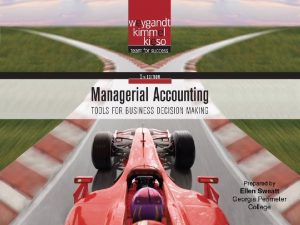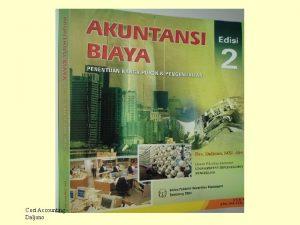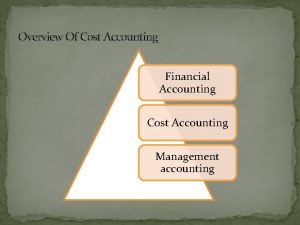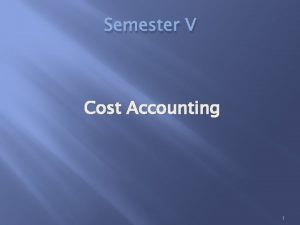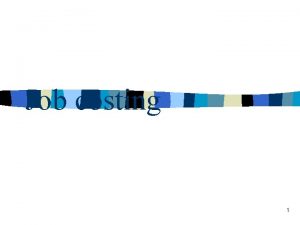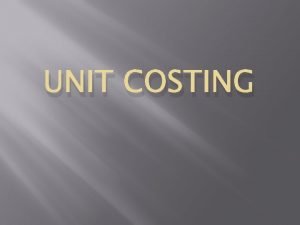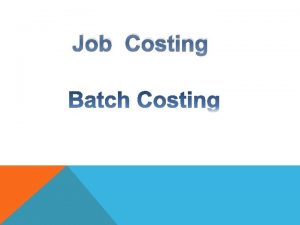COST ACCOUNTING METHODS OF COSTING METHODS OF COSTING











- Slides: 11

COST ACCOUNTING METHODS OF COSTING

METHODS OF COSTING 1. Unit Costing 2. Job Costing 3. Batch Costing 4. Contract Costing 5. Process Costing 6. Operating Costing 7. Operation Costing 8. Multiple Costing

METHODS OF COSTING 1) Unit Costing: § This is also known as single or output costing. This method is suitable for industries where the manufacture is continuous and units are identical. This method is applied in industries like mines, quarries, cement works, brick works, etc. § In all these industries there is natural or standard unit of cost, for example, tonne of coal in collieries, tonne of cement, one thousands of bricks, etc. The object of this method is to ascertain the cost per unit of output and the cost of each element of such cost. § Here the cost account takes the form of cost sheet or statement prepared for a definite period. The cost per unit is determined by dividing the total expenditure incurred during a given period by the number of units produced during that period.

METHODS OF COSTING 2) Job Costing: § Under this method costs are collected and accumulated for each job or work order or project separately. Each job can be identified separately and hence becomes essential to analyze the costs according to each job. § Normally production consists of distinct jobs or lots so that order number can identify costs. A job card is prepared for each job for cost accumulation. This method is suitable for Printers, Machine tool manufacturers, Foundries, and general engineering workshops.

METHODS OF COSTING 3) Batch Costing: § This is an extension of job costing. A batch may represent a number of small orders or group of identical products passed through the factory in batch. Each batch is treated as a cost unit and cost is ascertained separately. § The cost per unit is determined by dividing the cost of the batch by the number of units produced in a batch. The manufacturers of biscuits, garments, spare parts and components mainly use this method.

METHODS OF COSTING 4) Contract Costing: § Contract costing does not in principle differ from job costing. When the job is big and spread over long period of time, the method of contract costing is used. A separate account is kept for each individual contract. Civil engineering contractors, constructional and mechanical engineering firms, builders, etc use this method. § In contracts, when it is agreed to pay an agreed sum or percentage to coverheads and profit to the contractors, it will be termed as ‘cost plus costing’. The term cost here refers to the prime cost. Usually government contracts are assigned in this basis.

METHODS OF COSTING 5) Process Costing: § A process refers here to a stage of production. If a product passes through different stages, each distinct and well defined, then in order to ascertain the cost at each stage or process, the process costing is used. Under this method, a separate process account is prepared and all costs incurred in that process are charged. § Normally the finished product of one process becomes the raw material of the subsequent process and a final product is obtained in the last process. As the products are manufactured in continuous process, this is also known as continuous costing. Process costing method is generally followed in textile units, chemical industries, refineries, etc.

METHODS OF COSTING 6) Operating Costing: § This is suitable for industries, which render services as distinct from those, which manufacture goods. This is applied in transport undertakings, power supply companies, gas, water works, municipal services, hospitals, hotels, etc. § It is used to ascertain the cost of services rendered. There is usually a compound unit in such undertakings, for example, tonne-kilometres or passenger-kilometres in transport companies, kilo-watt-hour in power supply, patient-day in hospitals, etc.

METHODS OF COSTING 7) Operation Costing: § It is a further refinement of process costing. It is suitable to industries where mass or repetitive production is carried out or where the goods have to be stocked in semi-finished stage, to enable the execution of special orders, or for the convenient use in later operations. § In this method, the cost unit is an operation. It is used in cycle manufacturing, automobile units, etc.

METHODS OF COSTING 8) Multiple Costing: § It is also called as composite costing. It represents the application of more than one method of costing in respect of the same product. This is suitable for industries where a number of component parts are separately produced and subsequently assembled into a final product. In such industries each component differs from others as to price, materials used, and manufacturing processes. § So it will be necessary to ascertain the cost of each component. For this purpose process costing may be applied. To ascertain the cost of the final product batch costing may be applied. This method is used in factories manufacturing cycles, automobiles, engines, radios, typewriter, aero plane and other complex products.

THANK YOU Any Doubt ? ? ? ?
 Site:slidetodoc.com
Site:slidetodoc.com Meaning of standard costing
Meaning of standard costing Companies that use job order costing
Companies that use job order costing Job order cost and process cost systems
Job order cost and process cost systems Difference between service costing and product costing
Difference between service costing and product costing Marginal costing meaning
Marginal costing meaning Manufacturing cost vs non manufacturing cost
Manufacturing cost vs non manufacturing cost Process costing
Process costing Difference between job costing and contract costing
Difference between job costing and contract costing Variable costing vs absorption costing
Variable costing vs absorption costing Income statement using marginal costing
Income statement using marginal costing Advantages of activity based costing
Advantages of activity based costing
